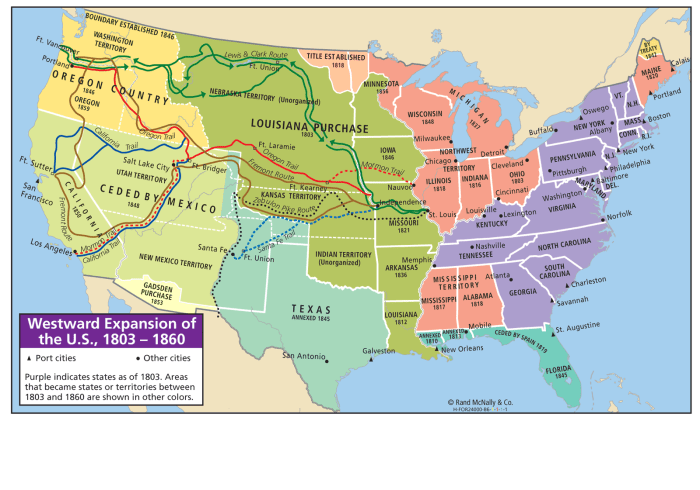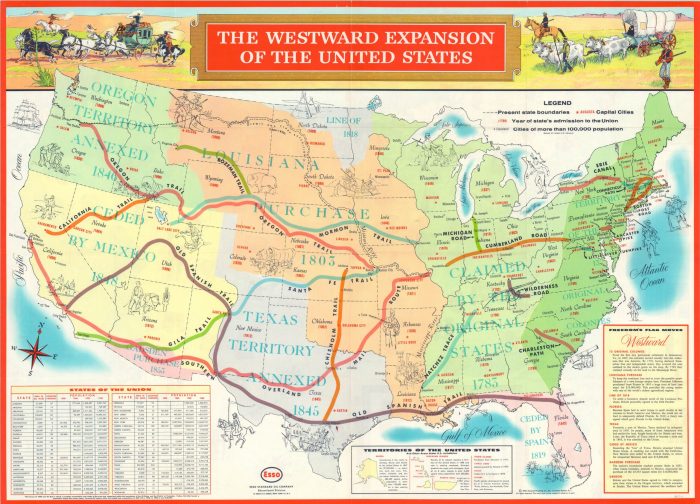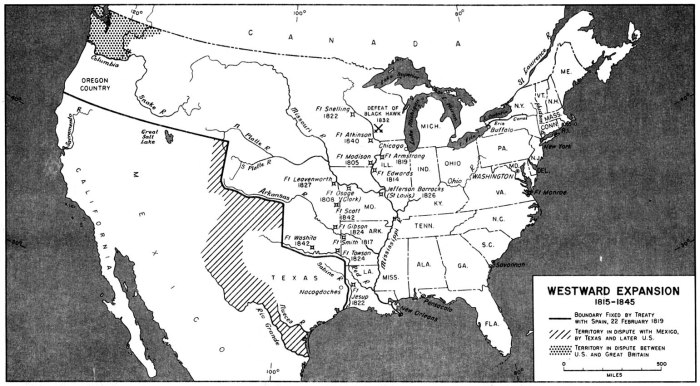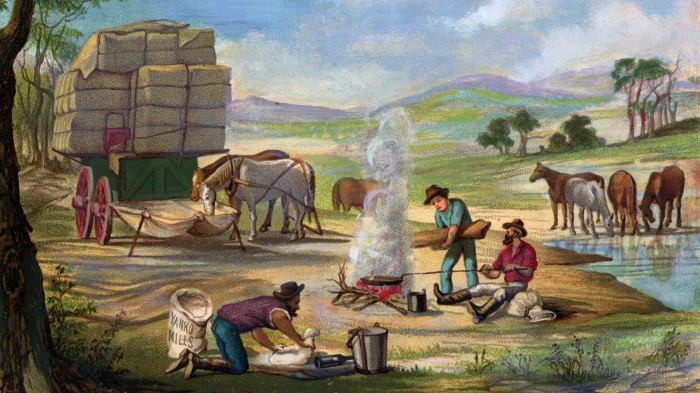Manifest Destiny in art wasn’t just a reflection of westward expansion; it actively shaped its narrative. From the sweeping landscapes of the Hudson River School to the stark realities captured in photography, artists powerfully depicted—and often justified—the relentless march across the American continent. This exploration delves into how the visual arts both fueled and critiqued the ideology of Manifest Destiny, revealing the complex interplay between artistic expression and historical events.
We’ll examine how paintings, photographs, and even contemporary art continue to grapple with the legacy of this pivotal era in American history, its impact on Native American communities, and its lasting environmental consequences.
Manifest Destiny in 19th-Century Art: Manifest Destiny In Art
Manifest Destiny, the 19th-century belief in the divinely ordained expansion of the United States across North America, found powerful expression in the art of the period. Paintings, photographs, and other visual media served not only to document the westward expansion but also to shape public perception and justify the often brutal realities of conquest and displacement. This exploration delves into the various ways artists depicted Manifest Destiny, revealing the complex interplay between ideology, artistic style, and the historical narrative of westward expansion.
Manifest Destiny in 19th-Century Painting

Nineteenth-century paintings played a crucial role in visually constructing the narrative of Manifest Destiny. Artists employed specific techniques and symbolic elements to portray westward expansion as a divinely sanctioned mission, often overlooking or minimizing the violence and displacement inflicted upon Native American populations. This section examines prominent paintings, recurring motifs, and artistic styles used to depict this pivotal era.
Recurring motifs frequently depicted in these artworks included idealized landscapes showcasing the bounty of the American West, pioneering families bravely venturing into the unknown, and triumphant encounters with nature. These images contrasted sharply with depictions of Native Americans, which often fell into stereotypes of savagery or romanticized notions of a vanishing race. The artistic styles ranged from the detailed realism of Albert Bierstadt to the more romanticized and dramatic style of Frederic Remington, each contributing to a multifaceted yet ultimately biased portrayal of Manifest Destiny.
| Painting | Subject Matter | Artistic Style | Portrayal of Manifest Destiny |
|---|---|---|---|
| Westward the Course of Empire Takes Its Way by Emanuel Leutze | A depiction of westward expansion, focusing on pioneers and settlers moving across the landscape. | Romantic, historical painting; influenced by the Hudson River School. | Emphasizes the progress and inevitability of American expansion, largely ignoring the displacement of Native Americans. |
| Among the Sierra Nevada, California by Albert Bierstadt | A majestic view of the Sierra Nevada mountains, showcasing the grandeur and beauty of the American West. | Detailed realism, characteristic of the Hudson River School. | Promotes the idea of the West as a land of immense natural resources and opportunity, available for American exploitation. |
| The Bronco Buster by Frederic Remington | Depicts a cowboy subduing a wild bronco, symbolizing the taming of the West. | Romantic realism, focusing on action and drama. | Illustrates the rugged individualism and mastery of nature associated with the American expansion narrative. The portrayal often downplays the violence inherent in westward expansion. |
The Role of Landscape in Visualizing Manifest Destiny

Landscape paintings were instrumental in shaping the ideology of Manifest Destiny. Artists used the vastness and beauty of the American West to visually communicate the idea of an expansive and divinely blessed nation. The use of light, color, and scale was crucial in conveying a sense of grandeur and inevitability.
Paintings supporting Manifest Destiny often employed vibrant colors and dramatic lighting to emphasize the abundance and promise of the land. The scale of the landscapes was immense, dwarfing human figures to highlight the seemingly limitless potential for expansion. Conversely, artworks that subtly or overtly challenged Manifest Destiny might use muted colors, focus on the fragility of the environment, or include prominent depictions of Native American presence to counter the dominant narrative.
Visual Comparison: A painting supporting Manifest Destiny might depict a sun-drenched valley, with lush vegetation and a clear blue sky, using a wide angle to showcase the expansive landscape. A contrasting piece might show a barren, scarred landscape, with dark, muted colors, and a small, isolated Native American figure, highlighting the environmental and human costs of westward expansion.
Portrayals of Native Americans in Art Reflecting Manifest Destiny, Manifest destiny in art

The portrayal of Native Americans in art during the Manifest Destiny era reflects the prevailing biases and prejudices of the time. These depictions often served to justify the dispossession and violence inflicted upon Indigenous populations. This section analyzes how Native Americans were represented in various artworks, highlighting the impact of these artistic representations on public perception and government policy.
- Romanticized portrayals: These often depicted Native Americans as noble savages, existing harmoniously with nature but ultimately destined to fade away in the face of progress. This romanticized image served to lessen the guilt associated with their displacement.
- Demonized portrayals: These images portrayed Native Americans as violent, savage, and inherently opposed to American progress. Such depictions provided justification for military action and the seizure of Native American lands.
- Neutral or realistic portrayals (rare): While less common, some artworks attempted to offer a more nuanced and balanced portrayal of Native American life and culture. However, these often lacked the widespread influence of the more prevalent romanticized or demonized representations.
These artistic representations significantly influenced public opinion, shaping perceptions of Native Americans as obstacles to progress, thereby contributing to policies of removal, assimilation, and ultimately, genocide.
Manifest Destiny in Photography and its Impact

Nineteenth-century photography played a significant role in documenting westward expansion and its consequences. Unlike paintings, which could be manipulated to present a particular narrative, photographs offered a seemingly objective record of events. However, even photographic representations were subject to biases in framing, selection, and presentation.
Photographs of landscapes, settlements, and encounters with Native Americans were widely circulated, contributing to the popularization and acceptance of Manifest Destiny. The immediacy and perceived objectivity of photographs reinforced the dominant narrative, influencing public opinion and justifying government policies. The impact of paintings and photographs was similar in shaping public perception, but photography, with its purported realism, potentially held even greater sway.
Photographic techniques such as framing, perspective, and the selection of subjects influenced the narrative of Manifest Destiny. For instance, a wide-angle shot emphasizing the vastness of the landscape could reinforce the idea of boundless opportunity, while a close-up focusing on a distressed Native American family could subtly challenge the narrative of inevitable progress.
The Legacy of Manifest Destiny in Contemporary Art
Contemporary artists continue to grapple with the complex legacy of Manifest Destiny. They re-examine the historical narratives, challenging the dominant interpretations and giving voice to marginalized perspectives, particularly those of Native Americans. This section explores how contemporary artists engage with the ongoing impact of Manifest Destiny.
Many contemporary works directly address the environmental consequences of westward expansion, the ongoing displacement of Native American communities, and the lasting effects of colonialism. Artists use a variety of media—painting, sculpture, photography, installation art—to explore these themes, offering critical perspectives on the idealized narratives of the past.
Hypothetical Artwork: A large-scale installation might use found objects and repurposed materials to create a landscape reflecting the environmental devastation caused by westward expansion. The work would incorporate fragmented images and texts from historical documents, juxtaposed with contemporary accounts of environmental damage and Native American displacement, prompting viewers to confront the ongoing consequences of Manifest Destiny.
Closure

The artistic portrayal of Manifest Destiny offers a multifaceted lens through which to understand this controversial period. From romanticized landscapes to the brutal realities faced by Native Americans, the art of the era reveals the complexities of westward expansion and its enduring impact. By examining these diverse artistic expressions, we gain a deeper appreciation for the ideology’s influence on both the physical and cultural landscape of America, prompting crucial reflection on its legacy and ongoing relevance in contemporary society.
The story isn’t simply one of conquest; it’s a nuanced narrative told through brushstrokes, photographic exposures, and the enduring power of artistic interpretation.
Detailed FAQs
What specific artistic movements embraced or challenged Manifest Destiny?
The Hudson River School, with its idealized landscapes, largely embraced Manifest Destiny. Conversely, later movements, such as some forms of realism and social realism, offered more critical perspectives, highlighting the negative consequences of westward expansion.
How did the portrayal of Manifest Destiny in art change over time?
Early portrayals often romanticized the West and minimized the suffering of Native Americans. Later art, especially in the 20th and 21st centuries, provides more critical and nuanced depictions, acknowledging the violence and displacement inherent in the westward expansion.
Were there any female artists who addressed Manifest Destiny in their work?
While less prominent than their male counterparts, some female artists did contribute to the visual narratives of the era, often focusing on domestic scenes or the experiences of women in the expanding West. Further research is needed to fully understand their contributions.